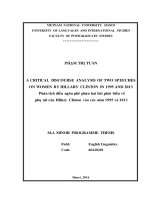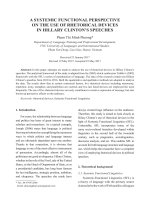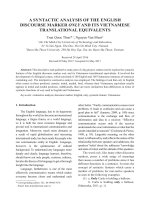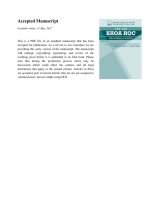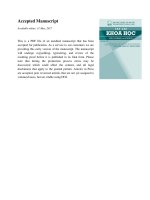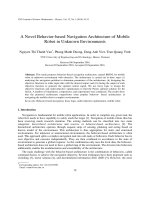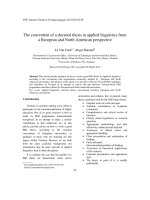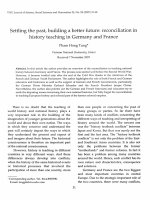DSpace at VNU: A process of building 3D models from images
Bạn đang xem bản rút gọn của tài liệu. Xem và tải ngay bản đầy đủ của tài liệu tại đây (1.27 MB, 6 trang )
VNU Joumal o f Science, M athem atics - Physics 23 (2007) 9-14
A process of building 3D models from images
Bui The Duy, Ma Thi Chau*
College o f Technology, VNU
144 Xuan Thuy, Cau Giay, Hanoi, Vietnam
Received 9 July 2007; received in revised form 5 September 2007
Abstract. Recently, a number of new technologies to capture 3D data have been đevelopeđ. The
application potential of 3D models is enormous, such as, in education, entertaúunent, medicine,
etc. In this paper, we present our work toward creatìng 3D model of free form objects from pair of
images. We use the basic process of building 3D models proposed in M ultipỉe View Geom eíry in
Computer Vision by Richard Harlley and Andrew Zisserman which includes three main phases:
Preprocessing, Matching, Depth Recovery.
1
. Introduction
Novvadays, 3D model building is getting more and more attention from the research community.
The rising attention is partly because of the technique’s promising applications in such areas as
arclutectural design, game produce, movie-postprocessing and so on. In order to have 3D models, the
traditions are normally used, in which technicians use specialized equipments to get 3D iníbrmation.
The method costs a lot of expenses. In other approach, technicians use prior knowledge of objects to
build the objects’ 3D models manually and then apply the texture on these models. However, the
methođs require enormous manual effort. On the other hand, 3D models’ qualities do not really meet
the demand of reality, because subjective factors can affect the result. Recently, many researchers have
+becn trying to find out robust as well as efficient methods to reconstruct 3D models. A new approach
is invcstigated to reduce the human effort is to build 3D models automatically from images [1].
In this paper, we inừoduce our work of creating 3D model automatically from pair of images.
Among many proposed methods we chose the framework proposed in [1] because of its completeness
and practicality. The primary process described in [1] includes three main phases: Preprocessing,
Matching, Depth Recovery. By combining and testing lots of related techniques and algorithms, we have
mtroduced an effectively completed process which uses two images of an object as input and then
automatically makes out the object’s 3D model as output. The whole process consists of six steps in
details: SUSAN comer extraction, SUSAN comer matching, F matrix computing, Polar rectification,
dense matching, and triangulation and texturing. The approach is a promising íeasible solution.
Section 2 gives an overview of the 3D model reconstruction and relevant techniques. We then
propose our process by associating selected techniques in Section 3. We then show the experiments
that we have done in Section 4.
* Corrcsponding author. Te!: 84-4-7547812
E-mail:
9
10
Bui The Duy, Ma Thi Chau / VNU Journal o f Science, Mathematics - Physics 23 (2007) 9-14
2. The 3D reconstruction process
The basic principle used in reconstructing 3D information is triangulation One [2]. In most
techniques, a triangle is created betxveen the object and two sensors. So, constructing 3D information
needs at least tvvo slightly different 2D images.
We follow the 3D reconstruction process introduced in [2], which is illustrated in Figure 1. The
process consists of three main phases: Preprocessing, Matching, Depth Recovery. These steps will
now be discussed in more details.
Figure 1. Main tasks of 3D reconstruction.
2.1. Preprocessing
The fĩrst step involves in relating two different images. In order to determine the geometric
relationship between images, it requires number of corresponding featurc points. Featurc points are
strongly diíĩerent from its neighbors in the image so it can be matched uniquely with a corresponding
point in another image. There are many kinds of feature points and methods of feature extraction
published [3]. These corresponding feature points are then used to determine the geometry constraints
between two images, which are mathematically expressed by the íundamental matrix.
2.2. Matching
At this step, input images are rectiíied accorđing to the fundamental matrix computed by first step.
Among the 3 main steps of the 3D reconstruction the matching step is extremely important. The above
feature matching is only spare matching. But we need all image points are matched for having a real
model. Image pairs are rectiíied so that epipolar lines coinciding with the image scan lines which
reduces the correspondence search to a matching of the image points along each image scan-line. In
rectification, pair of images is re-sampled so as to make imposing the two vievv geometry constraints
simple. As a result, most image points in the first images are corresponding to image points in the
second one.
2.3. Dept/i rccovery
At this stage, by dense disparily matching determined in the second step, 3D information oí all
image points is computed. Triangulation principle and optimal triangulation method [2] are used to
Bui The Duy, Ma Thi Chau / VNV Journal o f Science. Mathematics - Physics 23 (2007) 9-14
11
estimates the depth of all image points or raw 3D model. After that, one of original images is used to
texture the raw model to have final 3D model.
3.
A proposed process
In this section we motivate and present our completed process of 3D model building and its
relation to others. The whole process is shown in íìgure 2.
Figure 2. A process o f 3D reconstruction.
3. í. SUSAN corner exíraction
Peature can be classiíìed as íeature area, feature line or íeature point. SUSAN (Smallest Univalue
Segment Assimilating Nucleus) comers are feature points vvhich are easily computed and efifective in
matching. To extract Susan comers, we use a circular mask. Its center is called nucleus. USAN
(Univalue Segment Assimilating Nucleus) area is deíined as an area including interested pixels which
havc the same brightness as nucleus’s brightness. The shape of USAN areas conveys important
information about the structure o f the image in the region around the nucleus [4]. An algorithm
proposed in [4] uses the iníormation by comparing the brightness diíĩerence betvveen the nucleus and
its neighbors (pixels within the same circular mask) to extract SƯSAN comers.
3.2. SƯSAN corner matching
Given a point C|(«|,V|) (a SUSAN comer íound in 3.1) in the first image, we use a correlation
\v in d o w o f size ( 2 « + l ) X ( 2 /n + l) , c e n te re d at th is p o in t. W e th en se le c t a re c ta n g u la r search a re a o f
size (2 d u+ 1)x(2dy+ 1) aro u n d th is p o in t in th e se co n d im age (c a lle d C2 ÌU2 ,V2)), and p e ríb rm a c o rre la tio n
opcration on a given window between C\ and c2 lying within the search area in the second image. The
correlation score, 5 (C|,C2 ), is deíìned as:
È
Ễ [à («1 + i »vi + j ) - / . ( U.» Vl ) Ị X [/ 2 ( « 2 + * > 2 + j ) - J 2 («2»V2)Ị
s ịr c ) = í= n J=~m_________________________________________________________________________________
(2n
+
l ) ( 2 m + l ) ự ơ 2 ( / ị ) x ơ 2 ( / 2)
12
Bui The Duy, Ma Thi Chau ỉ VNU Journaỉ o f Science, Mathematics - Physics 23 (2007) 9 -Ị4
where as,
n
m
I k {u,v)= Ỵ2 ]C /*(« + *»« + j ) / ( 2 n + l)( 2 m + l).* =1.2o (/l )
is the S tandard d e v ia tio n of th e im a g e Ik in th e n e ig h b o u rh o o d (2/1+1) X ( 2 w + l) o f (w.v), w hich is
gi ven by:
The score ranges from 1 down to -1 for two coưelation windows which are similar or not. A
constraint on the correlation score is then applied in order to select the most consistent matches: íbr a
given pair of points to be considered as a candidate match, the correlation score must be higher than a
given threshold. For each point in the first image, we thus have a set of candidate matches from the
second one and vice versa. So we use some techniques known as relaxation techniques [5, 6 ] to
resolve the matching ambiguities. The idea is to allow the candidate matches to reorganize themselves
by propagatíng some constraints, such as continuity and uniqueness, through the neighborhood.
3.3. Fundamental matrỉx
Fundamental matrix 3 X 3 F expresses mathematically the geometry constraints betwcen two
images. Hartley [2] has pointed out RANSAC algorithm, a simple method, to compute F matrix. This
matrix can be found by solving 8 linear equations. So, iVsamples o f feature matching couples are used
not only to compute F matrix but also to reíìne it.
3.4. Polar recti/ìcation
Rectiíĩcation is an important step aim to save time and cost in matching by reducing the size of
search area. Polar rectiĩication transforms input images from Deccacter co-ordinate {x,y) into polar coordinate (r,0) [7] (íĩgure 3). We use rectified images as input o f matching step. As a result of
rectiíìcation, in matching, instead of searching corresponding point in the whole second image, we
only search it in a speciíĩc scanline.
X
y
\•
Figure 3. Co-ordinate transíormation.
5.5. Dense matching
Each pixel (x,y) in the íìrst image we put a correlation window such as (x,y) is the position of
window’s center. We find out ( x \ y r) matching with (x,j) by changing another window on scanline of
Bui The Duy, Ma Thi Chau / VNU Journal o f Science, Mathematics - Physics 23 (2007) 9-14
13
(x,y ) in th c sc c o n d im age. D is p a rity o f th e tw o w in d o w d e te rm in e i f (x ,y ) a n d ( x \ y n) a re m a tc h in g p a ir.
The disparity is calculated by SAD (Sum of Absolute Differences) as follow:
Ị/, ( x + i ,y + j ) - /j [ x + d + i , ỳ + j)|
c(x,y,d) = —
— -----=
I Ụ l , ( x + h y + j) x
------- ----
■
+ d + i , ý + j)
where as /* is the mean of the klh window’s grey intensities
Nishihara [8 ] has suggested some correlation window’s sizes to increase matching accuracy.
3.6. Triangulation and texturing
For each 3D to 2D coưespondence (X, x), we have prọịection equation X = PX, where as X and x'
are image points. X is related point in 3-space. p and P' are camera maứices [2]. A X = 0 is a result of
combining the two equations. Singular Value Decomposition [2] is an effective way to compute X.
Fortunate]y, between (p , P") and íundamental matrix has a great constraint [2] we can easily
compute one from other and in tum. We can have unique F matrix {rom p and p \ However, pair of p
and P ' is not unique One from a specific matrix F. We choose p and P ' as follow
p= [/10] and P'= [[e']xF + e \ J\ke']
whcre as Vis a three-dimension vector and \ is a non-zero constant.
In rcality there are many matching points between the two images. Thereíore, it was necessary to
computc an algorithm that is going to choose a corresponding point írom the second image with the
highest confident level.
4.
Experim ents and discussion
In this section we give the results of our technique on synthetic and real data. The synthetic
expcnment Setup is based on some related work. We have two input images (fìg\ưe 4 a, b). Figure 4c
shows Susan comers computed get írom two original images. Pair o f rectifíed images are presented in
Figure 5a, b, and íĩgure 5c is the picture of the 3D resultant model.
a,
b,
Figure 4. a,b Two original 480x640 images; c, Susan comcrs.
c,
Bui The Duy, Ma Thi Chau / VNU Journa! o f Science, Mathematics - Physics 23 (2007) 9-14
14
m
'ỈÍX'
■
ị P s Ị g P p iề
..
X
w
a,
sỹ
b,
c,
Figure 5. a,b Pair o f rectified images; c, 3D resuỉtant modeỉ.
The process involved to two input images. Two images suitable for the initialization process are
selected so that they are not too close to each other on the one hand and there are sufficient features
matched betvveen these two images on the other hand. Hovvever, there are still some inexact areas in
the 3D model because o f occlusion and the simplicity of the used algorithms [6 , 9]. The result can be
reíìned each time a nevv vievv (image) is added. In future, to improve the quality vve will try to use
more sophisticated algorithms as well as increase the amount of images.
5. Conclusion
We presented in this paper our work tovvard the creating of a 3D model from two images. Using a
building process in thee steps, vve have generated a 3D model of a free-from view with a fair overall
quality. In the future vve want to improve the reconstruction process more in order to have a more
detailed and accurate 3D model.
Reíerences
[11 R. Sablatnig, M. Kampel, Computing relative disparity maps/rom stereo images, ERASMUS Intensive Program, Pavia,
Italy, 2 0 0 1 .
[2| R. Hartiey, A. Zisserman, Multiple View Geometry in Computer V isio n , Cambridge University prcss, 2000.
[3| c. Harris, M. Stcphens, A combined corner and edge detector, Fourth Alvey Vision Conícrence (1988) 147.
|4) S.M. Smith, J.M. Brady, s u SAN - a new approach to low level image Processing, Springer Nctherlands, 2004.
Ị5) Oliver Paugeras Bemard, Real time corrclation-based stereo: algorithm, implementation and application. Technical
Report 2013, ỈNR1A, Institut National de Recherche cn Inĩormatiquc ct en Automatiquc, 1993.
|6Ị T. Kanade, M. Okutomi, A Stereo Matching Algorithm vvith an adaptivc window: Theory and Experiment, Paitcm
Analysis and Machine Intelligence, IE E E Transactions 16, ỉ 994.
|7Ị R.I. Hartley, Thcory and practice of projectivc rectification, Technical Report 2538, INR1A, Institut National dc
Rechcrchc en Iníbrmatique et en Automatique, 1995.
[8 | H.K. Nishihara. PR1SM, A Practical Real-Time Imaging Stereo matcher, Technìcal Report A.I. Memo 780, MIT,
Cambridge, MA, 1984.
[9] U.R. Dhond, J.K. Aggarwal, “Structurc from Sterco - A Revicvv”, IEEE Tran. Man and Cybernetics 19 (1989) 1489.

